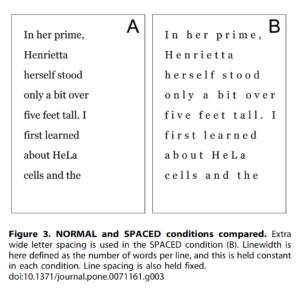Short answer: NO.
As at least half of the schools across the country closed for health reasons, students from the earliest ages to post-graduates find themselves schooling from home, usually through online programs.
In the best situations, students have smoothly or semi-smoothly transitioned to distance learning. In the worst, students don’t log on, and uncertainty exists as to whether there are sufficient resources (like devices and internet access) or if they know how to get connected. Teachers and school systems are undertaking many out-of-the box solutions to get entire classrooms online.
What does that mean for dyslexic students?
A report from NWEA (Northwest Evaluation Association) warns about potential “COVID Slide” or potential losses that occur when schools are not in session. The education researchers are extrapolating based on what they have observed in students following summer vacation:
“While there is some controversy about the magnitude of summer learning loss, three trends are consistent across seasonal learning research findings: achievement typically slows or declines over the summer months, declines tend to be steeper for math than for reading, and the extent (proportionally) of loss increases in the upper grades.”
The NWEA is concerned that school closures because of the virus will be twice the duration of summer vacation, with significant impacts on school achievement.
While these are legitimate concerns, all students are in this boat together, and assuming that you’re able to read this newsletter, you’ve at least been able to find our organization Dyslexic Advantage and read this magazine online.
Because we’re all in this chaotic present together, I think for the majority of dyslexic families – this period of COVID schooling can have some incidental benefits.

Shorter School Days and More Technology
First, assuming schools are not requiring full online days for school (those that do are making a big mistake), many dyslexic students will have more ‘down time’ in their school day, which is a good thing. Many students fare better when able to move around and focus their concentration in short bursts.
Technology usually benefits dyslexic students as well if they are given a chance to experiment with and learn what a system can do. Remote learning may also be a great opportunity to ensure that all accommodations are in place and that your student has all the access to information and reading, writing, spelling, and math supports they may need.
With online classes, students may be able to dictate their responses and have text read aloud…something that often isn’t done in conventional classrooms.
Parents Can Learn More About Their Student’s Experience in School
Parents may learn more about their students’ experiences in school – whether positive or negative or both. Sometimes sending students off to school is a little bit like a ‘black box’ – where you can’t see what happens.
With live classes or recorded classes, it may be much easier to see what your student has trouble with or where she or he gets lost. At the same time, you also might get a chance to hear your student shine in an online classroom discussion.
Be Prepared to Advocate If You Need To
If your student is having trouble, then speak up about needs. Students (and families and teachers) are under great stress right now and few schools have established routines and protocols.
To read more about what other families are going through, check out “I just can’t do this…”
If students aren’t tech savvy, they may have difficulty learning and working with the new platform. The stress and uncertainty of the current situation is also likely to take its toll on working memory and emotional well-being.
– Keep your teacher informed about difficulties your student could be having with communication as well as with assigned work.
– Request fewer assignments and more time if necessary to complete assignments.
– Request permission to record classes.
– If supports are lacking, be prepared to request out-of-the-box solutions to problems that arise because of the pandemic.
For instance, if classroom discussions aren’t in a college course, but you need discussion to comprehend material, then request an online tutor through the student support office. If none is available, contact a classmate and see if they might be willing to study together online.
If your student was given worksheet packets to complete and she or he is struggling with the quantity of material assigned or experiencing undo stress from being unable to keep up with the amount of work, request a reprieve and share the information with your teacher. With remote schooling, teachers can’t see if students are getting overwhelmed or if assignments are piling up at home.
Communicate frequently in an informative and non-emotional way until expectations are manageable for all concerned. Tell your teacher if the amount of reading with the switch to distance learning is too much. If online discussions are overwhelming, shy students may have trouble thinking of what they want to say when everyone in class is looking at them. This sort of thing can also make ‘tip of the tongue’ problems worse. Teachers can help by giving students the questions that they will ask them the day before – it can help students to prepare as well as build confidence.
Finally, try not to worry if you decide to take a break from formal schooling. These are unusual times.
If you wanted to keep up a little reading and your student hasn’t yet gotten used to reading along with listening, this period would be a great time to find a platform and workflow with technology.
If you need to certify as having dyslexia to qualify individually for Ebook or audiobook resources from Bookshare or Learning Ally, various psychological associations have made announcements that their professionals are permitted to use “telemedicine” during this time of the pandemic. Also dyslexia screening is available through Neurolearning.com using an iPad, iPhone, or Android devices (for ages 7-70). 
There has been some suggestion that the earlier people start with reading along with listening, the easier it will become. Some students struggle with this because of working memory being overwhelmed or problems with divided attention. If this is the case, have a student practice with a short passage (a book chapter or less depending on age), listening first, then re-listening while reading along while the text is highlighted. Having already heard the chapter first, reduces the work of having to figure what’s being said while following the text by eye. Doing this does provide more print exposure and training and it’s much better than not reading or listening alone.
Try reading on a phone and adjust the display so only a few words are visible at a time – it may reduce the work of reading and make it more enjoyable.
















